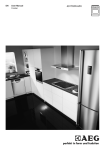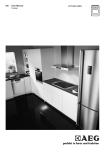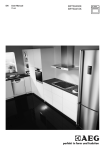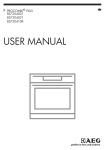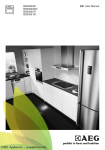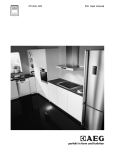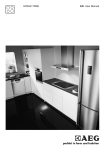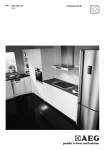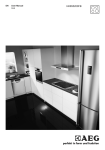Download AEG 49176V-MN cooker
Transcript
EN User Manual Cooker 49176V-MN 2 www.aeg.com CONTENTS 1. SAFETY INFORMATION.................................................................................................3 2. SAFETY INSTRUCTIONS................................................................................................ 5 3. PRODUCT DESCRIPTION.............................................................................................. 7 4. BEFORE FIRST USE.........................................................................................................8 5. HOB - DAILY USE............................................................................................................ 9 6. HOB - HINTS AND TIPS............................................................................................... 13 7. HOB - CARE AND CLEANING.....................................................................................14 8. OVEN - DAILY USE .......................................................................................................14 9. OVEN - CLOCK FUNCTIONS...................................................................................... 20 10. OVEN - HINTS AND TIPS...........................................................................................20 11. OVEN - CARE AND CLEANING................................................................................ 30 12. TROUBLESHOOTING.................................................................................................33 13. INSTALLATION........................................................................................................... 35 FOR PERFECT RESULTS Thank you for choosing this AEG product. We have created it to give you impeccable performance for many years, with innovative technologies that help make life simpler features you might not find on ordinary appliances. Please spend a few minutes reading to get the very best from it. Visit our website for: Get usage advice, brochures, trouble shooter, service information: www.aeg.com Register your product for better service: www.registeraeg.com Buy Accessories, Consumables and Original spare parts for your appliance: www.aeg.com/shop CUSTOMER CARE AND SERVICE Always use original spare parts. When contacting our Authorised Service Centre, ensure that you have the following data available: Model, PNC, Serial Number. The information can be found on the rating plate. Warning / Caution-Safety information General information and tips Environmental information Subject to change without notice. ENGLISH 1. 3 SAFETY INFORMATION Before the installation and use of the appliance, carefully read the supplied instructions. The manufacturer is not responsible if an incorrect installation and use causes injuries and damages. Always keep the instructions with the appliance for future reference. 1.1 Children and vulnerable people safety WARNING! Risk of suffocation, injury or permanent disability. • • • • • • This appliance can be used by children aged from 8 years and above and persons with reduced physical, sensory or mental capabilities or lack of experience and knowledge if they have been given supervision or instruction concerning use of the appliance in a safe way and understand the hazards involved. Do not let children play with the appliance. Keep all packaging away from children. Keep children and pets away from the appliance when it operates or when it cools down. Accessible parts are hot. If the appliance has a child safety device, we recommend you activate it. Cleaning and user maintenance shall not be made by children without supervision. 1.2 General Safety • • • Only a qualified person must install this appliance and replace the cable. Do not operate the appliance by means of an external timer or separate remote-control system. Unattended cooking on a hob with fat or oil can be dangerous and may result in fire. 4 www.aeg.com • • • • • • • • • • • • • Never try to extinguish a fire with water, but switch off the appliance and then cover flame e.g. with a lid or a fire blanket. Do not store items on the cooking surfaces. Do not use a steam cleaner to clean the appliance. Metallic objects such as knives, forks, spoons and lids should not be placed on the hob surface since they can get hot. If the glass ceramic surface / glass surface is cracked, switch off the appliance to avoid the possibility of electric shock. Internally the appliance becomes hot when in operation. Do not touch the heating elements that are in the appliance. Always use oven gloves to remove or put in accessories or ovenware. Before maintenance cut the power supply. Ensure that the appliance is switched off before replacing the lamp to avoid the possibility of electric shock. Do not use harsh abrasive cleaners or sharp metal scrapers to clean the glass door since they can scratch the surface, which may result in shattering of the glass. If the supply cord is damaged, it must be replaced by the manufacturer, its Authorised Service Centre or similarly qualified persons in order to avoid a hazard. Only use the core temperature sensor recommended for this appliance. To remove the shelf supports first pull the front of the shelf support and then the rear end away from the side walls. Install the shelf supports in the opposite sequence. The means for disconnection must be incorporated in the fixed wiring in accordance with the wiring rules. ENGLISH 5 2. SAFETY INSTRUCTIONS 2.1 Installation WARNING! Only a qualified person must install this appliance. • Remove all the packaging. • Do not install or use a damaged appliance. • Obey the installation instruction supplied with the appliance. • Always be careful when you move the appliance because it is heavy. Always wear safety gloves. • Do not pull the appliance by the handle. • The kitchen cabinet and the recess must have suitable dimensions. • Keep the minimum distance from the other appliances and units. • Make sure that the appliance is installed below and adjacent safe structures. • Parts of the appliance carry current. Close the appliance with furniture to prevent touching the dangerous parts. • The sides of the appliance must stay adjacent to appliances or to units with the same height. • Do not install the appliance on a platform. • Do not install the appliance adjacent to a door or under a window. This prevents hot cookware to fall from the appliance when the door or the window is opened. • Make sure to install a stabilizing means in order to prevent tipping of the appliance. Refer to Installation chapter. 2.2 Electrical Connection WARNING! Risk of fire and electrical shock. • All electrical connections should be made by a qualified electrician. • The appliance must be earthed. • Make sure that the electrical information on the rating plate agrees • • • • • • • • • • with the power supply. If not, contact an electrician. Always use a correctly installed shockproof socket. Do not use multi-plug adapters and extension cables. Do not let mains cables touch or come near the appliance door, especially when the door is hot. The shock protection of live and insulated parts must be fastened in such a way that it cannot be removed without tools. Connect the mains plug to the mains socket only at the end of the installation. Make sure that there is access to the mains plug after the installation. If the mains socket is loose, do not connect the mains plug. Do not pull the mains cable to disconnect the appliance. Always pull the mains plug. Use only correct isolation devices: line protecting cut-outs, fuses (screw type fuses removed from the holder), earth leakage trips and contactors. The electrical installation must have an isolation device which lets you disconnect the appliance from the mains at all poles. The isolation device must have a contact opening width of minimum 3 mm. Fully close the appliance door, before you connect the mains plug to the mains socket. 2.3 Use WARNING! Risk of injury and burns. Risk of electrical shock. • Use this appliance in a household only. • Do not change the specification of this appliance. • Make sure that the ventilation openings are not blocked. • Do not let the appliance stay unattended during operation. • Deactivate the appliance after each use. 6 www.aeg.com • Be careful when you open the appliance door while the appliance is in operation. Hot air can release. • Do not operate the appliance with wet hands or when it has contact with water. • Do not use the appliance as a work surface or as a storage surface. WARNING! Risk of fire and explosion • Fats and oil when heated can release flammable vapours. Keep flames or heated objects away from fats and oils when you cook with them. • The vapours that very hot oil releases can cause spontaneous combustion. • Used oil, that can contain food remnants, can cause fire at a lower temperature than oil used for the first time. • Do not put flammable products or items that are wet with flammable products in, near or on the appliance. • Do not let sparks or open flames to come in contact with the appliance when you open the door. • Open the appliance door carefully. The use of ingredients with alcohol can cause a mixture of alcohol and air. WARNING! Risk of damage to the appliance. • To prevent damage or discoloration to the enamel: – do not put ovenware or other objects in the appliance directly on the bottom. – do not put water directly into the hot appliance. – do not keep moist dishes and food in the appliance after you finish the cooking. – be careful when you remove or install the accessories. • Discoloration of the enamel has no effect on the performance of the appliance. It is not a defect in the sense of the warranty law. • Use a deep pan for moist cakes. Fruit juices cause stains that can be permanent. • Do not keep hot cookware on the control panel. • Do not let cookware boil dry. • Be careful not to let objects or cookware fall on the appliance. The surface can be damaged. • Do not activate the cooking zones with empty cookware or without cookware. • Do not put aluminium foil on the appliance or directly on the bottom of the appliance. • Cookware made of cast iron, aluminium or with a damaged bottom can cause scratches. Always lift these objects up when you have to move them on the cooking surface. • This appliance is for cooking purposes only. It must not be used for other purposes, for example room heating. 2.4 Care and Cleaning WARNING! Risk of injury, fire, or damage to the appliance. • Before maintenance, deactivate the appliance. Disconnect the mains plug from the mains socket. • Make sure the appliance is cold. There is the risk that the glass panels can break. • Replace immediately the door glass panels when they are damaged. Contact the Service. • Be careful when you remove the door from the appliance. The door is heavy! • Clean regularly the appliance to prevent the deterioration of the surface material. • Remaining fat or food in the appliance can cause fire. • Clean the appliance with a moist soft cloth. Only use neutral detergents. Do not use abrasive products, abrasive cleaning pads, solvents or metal objects. • If you use an oven spray, obey the safety instructions on the packaging. • Do not clean the catalytic enamel (if applicable) with any kind of detergent. ENGLISH 2.5 Internal light 2.6 Disposal • The type of light bulb or halogen lamp used for this appliance is only for household appliances. Do not use it for house lighting. WARNING! Risk of electrical shock. • Before replacing the lamp, disconnect the appliance from the power supply. • Only use lamps with the same specifications. WARNING! Risk of injury or suffocation. • Disconnect the appliance from the mains supply. • Cut off the mains cable and discard it. • Remove the door catch to prevent children and pets to get closed in the appliance. 3. PRODUCT DESCRIPTION 3.1 General overview 8 3 2 1 2 3 4 5 1 5 4 3 2 1 7 3 4 6 5 7 Control panel and hob Air vents for the cooling fan Heating element Lamp Shelf support, removable Socket for the core temperature sensor 7 Fan 8 Shelf positions 1 2 3 4 5 6 8 www.aeg.com 3.2 Cooking surface layout 1 2 145 mm 3 120/180 mm 120/175/210 mm 180 mm 4 6 1 Cooking zone 1200 W 2 Steam outlet - number and position depend on the model 3 Cooking zone 700 / 1700 W 4 Cooking zone 1800 W 5 Control panel 6 Cooking zone 800 / 1600 / 2300 W 5 3.3 Accessories • Wire shelf For cookware, cake tins, roasts. • Grill- / Roasting pan To bake and roast or as pan to collect fat. • Trivet For roasting and grilling. Use the trivet only with the Grill- / roasting pan. • Core temperature sensor To measure how far the food is cooked. 4. BEFORE FIRST USE WARNING! Refer to Safety chapters. 4.1 Initial Cleaning Remove all accessories and removable shelf supports from the appliance. Refer to "Care and cleaning" chapter. Clean the appliance before first use. Put the accessories and the removable shelf supports back to their initial position. 4.2 Using the sensor fields To activate a function touch and hold the selected symbol on the display for minimum 1 second. 4.3 Setting the time You must set the time before you operate the oven. When you connect the appliance to the electrical supply or after a power cut, the indicator for the Time function flashes. Press the or to set the correct time. After approximately five seconds, the flashing stops and the display shows the time of day you set. You can only change the time if: • The child safety device is not on. • None of the clock functions Duration or End is set. • No oven function is set. 4.4 Preheating Preheat the empty appliance to burn off the remaining grease. ENGLISH 4. Let the appliance operate for 15 minutes. Preheat the two ovens. Heat up one oven at a time. Set the functions listed below, if applicable. 5. Set the function and the maximum temperature. 6. Let the appliance operate for 15 minutes. Accessories can become hotter than usual. The appliance can emit an odour and smoke. This is normal. Make sure that the airflow in the room is sufficient. 1. Set the function and the maximum temperature. 2. Let the appliance operate for 1 hour. 3. Set the function temperature. 9 and the maximum 5. HOB - DAILY USE WARNING! Refer to Safety chapters. 5.1 Hob control panel 1 2 3 4 5 12 6 7 11 10 8 9 Use the sensor fields to operate the appliance. The displays, indicators and sounds tell which functions operate. Sensor Function field Comment 1 ON / OFF 2 Lock / The Child Safety De- To lock / unlock the control panel. vice 3 STOP+GO To activate and deactivate the function. 4 - To activate and deactivate the outer ring. - Heat setting display To show the heat setting. - Timer indicators of cooking To show for which zone you set the time. zones - Timer display To show the time in minutes. - To activate and deactivate the outer ring. 5 6 7 8 To activate and deactivate the hob. 10 www.aeg.com Sensor Function field 9 / 10 11 12 - Comment - To select the cooking zone. - To increase or decrease the time. Automatic Heat Up To activate and deactivate the function. Control bar To set a heat setting. 5.2 Heat setting displays Display Description The cooking zone is deactivated. The cooking zone operates. - STOP+GO function operates. Automatic Heat Up function operates. + digit There is a malfunction. / OptiHeat Control (3 step Residual heat indicator): continue cooking / keep warm / residual heat. / Lock / The Child Safety Device function operates. Automatic Switch Off function operates. 5.3 OptiHeat Control (3 step Residual heat indicator) WARNING! / / There is a risk of burns from residual heat. The indicator shows the level of the residual heat. 5.4 Activating and deactivating Touch for 1 second to activate or deactivate the hob. 5.5 Automatic Switch Off The function deactivates the hob automatically if: • all cooking zones are deactivated, • you do not set the heat setting after you activate the hob, • you spill something or put something on the control panel for more than 10 seconds (a pan, a cloth, etc.). An acoustic signal sounds and the hob deactivates. Remove the object or clean the control panel. • you do not deactivate a cooking zone or change the heat setting. After some time deactivates. comes on and the hob ENGLISH The relation between the heat setting and the time after which the hob deactivates: Heat setting ,1-3 The hob deactivates after 6 hours 11 When you activate the zone but do not activate the outer ring the light that comes out from the zone may cover the outer ring. It does not mean that the outer ring is activated. To see if the ring is activated check the indicator. 4-7 5 hours 8-9 4 hours 5.8 Automatic Heat Up 10 - 14 1.5 hour If you activate this function you can get a necessary heat setting in a shorter time. The function sets the highest heat setting for some time and then decreases to the correct heat setting. 5.6 The heat setting To set or change the heat setting: Touch the control bar at the correct heat setting or move your finger along the control bar until you reach the correct heat setting. To activate the function the cooking zone must be cold. To activate the function for a cooking zone: touch ( comes on). Immediately touch the correct heat comes on. setting. After 3 seconds To deactivate the function: change the heat setting. 5.9 Timer 5.7 Activating and deactivating the outer rings You can adjust the surface you cook to the dimension of the cookware. Use sensor field: To activate the outer ring: touch the sensor field. The indicator comes on. To activate more outer rings: touch the same sensor field again. The subsequent indicator comes on. To deactivate the outer ring: touch the sensor field until the indicator goes out. Count Down Timer You can use this function to set how long the cooking zone should operate for a single cooking session. First set the cooking zone then set the function. You can set the heat setting before or after you set the function. To set the cooking zone: touch again and again until the indicator of a necessary cooking zone comes on. of To activate the function: touch the timer to set the time (00 - 99 minutes). When the indicator of the cooking zone starts to flash slowly the time counts down. To see the remaining time: set the cooking zone with . The indicator of the cooking zone starts to flash quickly. The display shows the remaining time. To change the time: set the cooking zone with . Touch or . 12 www.aeg.com To deactivate the function: set the 5.10 STOP+GO cooking zone with and touch . The remaining time counts back to 00. The indicator of the cooking zone goes out. To deactivate the function you can also This function sets all cooking zones that operate to the lowest heat setting. touch and at the same time. When the time comes to an end, the sound operates and 00 flashes. The cooking zone deactivates. To stop the sound: touch . CountUp Timer (The count up timer) You can use this function to monitor how long the cooking zone operates. To set the cooking zone: touch again and again until the indicator of a necessary cooking zone comes on. To activate the function: touch of comes on. When the the timer. indicator of the cooking zone starts to flash slowly the time counts up. The display switches between counted time (minutes). and When the function operates, you cannot change the heat setting. The function does not stop the timer functions. To activate the function: touch comes on. To deactivate the function: touch . The previous heat setting comes on. 5.11 Lock You can lock the control panel while cooking zones operate. It prevents an accidental change of the heat setting. Set the heat setting first. To activate the function: touch . comes on for 4 seconds. The Timer stays on. To deactivate the function: touch . The previous heat setting comes on. When you deactivate the hob, you also deactivate this function. To see how long the cooking zone operates: set the cooking zone with . The indicator of the cooking zone starts to flash quickly. The display shows how long the zone operates. To deactivate the function: set the cooking zone with and touch or . 5.12 The Child Safety Device This function prevents an accidental operation of the hob. . The indicator of the cooking zone goes out. To activate the function: activate the Minute Minder You can use this function as a Minute Minder when the hob is activated and the cooking zones do not operate (the Touch To deactivate the function: activate the heat setting display shows hob with ). To activate the function: touch . Touch or of the timer to set the time. When the time comes to an end, the sound operates and 00 flashes. To stop the sound: touch . The function has no effect on the operation of the cooking zones. hob with . Do not set the heat setting. for 4 seconds. Deactivate the hob with Touch comes on. . . Do not set the heat setting. for 4 seconds. Deactivate the hob with comes on. . To override the function for only one cooking time: activate the hob with . comes on. Touch for 4 seconds. Set the heat setting in 10 seconds. You can operate the hob. When you deactivate the hob with operates again. the function ENGLISH 5.13 Power management function • All cooking zones are connected as on the illustration. • The hob and both ovens are connected to one phase. • The phase has a maximum electricity load. • The function divides the power within the appliance. The oven is more important than the hob. • The function activates when the total electricity load in the appliance is exceeded. • The function decreases the power on the cooking zones to prevent a circuit overload. 13 • The heat setting display of the reduced zones changes between two levels. 6. HOB - HINTS AND TIPS WARNING! Refer to Safety chapters. 6.1 Cookware The bottom of the cookware must be as thick and flat as possible. • Put cookware on a cooking zone before you start it. • Use the residual heat to keep the food warm or to melt it. • The bottom of the pans and cooking zones must have the same dimension. 6.3 Examples of cooking applications Cookware made of enamelled steel and with aluminium or copper bottoms can cause the colour change on the glassceramic surface. The data in the table is for guidance only. 6.2 Energy saving • If it is possible, always put the lids on the cookware. Heat setting Use to: Time (min) Hints Keep cooked food warm. as necessary Put a lid on the cookware. 1-3 Hollandaise sauce, melt: butter, chocolate, gelatine. 5 - 25 Mix from time to time. 1-3 Solidify: fluffy omelettes, baked eggs. 10 - 40 Cook with a lid on. -1 14 www.aeg.com Heat setting Use to: Time (min) Hints 3-5 Simmer rice and milkbased dishes, heating up readycooked meals. 25 - 50 Add the minimum twice as much liquid as rice, mix milk dishes part procedure through. 5-7 Steam vegetables, fish, meat. 20 - 45 Add some tablespoons of liquid. 7-9 Steam potatoes. 20 - 60 Use max. ¼ l water for 750 g of potatoes. 7-9 Cook larger quantities of food, 60 - 150 stews and soups. Up to 3 l liquid plus ingredients. 9 - 12 Gentle fry: escalope, veal cordon bleu, cutlets, rissoles, sausages, liver, roux, eggs, pancakes, doughnuts. as necessary Turn halfway through. 12 - 13 Heavy fry, hash browns, loin steaks, steaks. 5 - 15 Turn halfway through. 14 Boil water, cook pasta, sear meat (goulash, pot roast), deep-fry chips. 7. HOB - CARE AND CLEANING WARNING! Refer to Safety chapters. 7.1 General information • Clean the hob after each use. • Always use cookware with clean bottom. • Scratches or dark stains on the surface have no effect on how the hob operates. • Use a special cleaner applicable for the surface of the hob. • Use a special scraper for the glass. 8. OVEN - DAILY USE WARNING! Refer to Safety chapters. 7.2 Cleaning the hob • Remove immediately: melted plastic, plastic foil, and food with sugar. If not, the dirt can cause damage to the hob. Put the special scraper on the glass surface at an acute angle and move the blade on the surface. • Remove when the hob is sufficiently cool: limescale rings, water rings, fat stains, shiny metallic discoloration. Clean the hob with a moist cloth and some detergent. After cleaning, rub the hob dry with a soft cloth. ENGLISH 15 8.1 Oven Control Panel 1 2 3 4 5 6 7 Use the sensor fields to operate the appliance Sensor field Function Comment – Display Shows the current settings of the appliance. 2 ON / OFF To activate or deactivate the oven. 3 Oven selection To move between top and main oven. Down key To move in the menu and to set an oven function or programme 5 Core temperature sensor To activate the Core temperature sensor function. 6 Return / Clock function selection To go back one level in the menu. To set the clock functions. Increase / Decrease To set the time and temperature value. 1 4 7 / 8.2 Indicators on the display A A B C D E F Name Description Top / Main oven indicator Shows which oven operates. G H 8 I 16 www.aeg.com Name Description B Oven function indicator Shows the function which is active. C Lamp / Defrost indicator Shows that the Lamp / Defrost function is active. D Heat-up and residual heat indicator Shows that the Heat-up / residual heat is active. E Temperature / Clock indicator Shows the temperature and the time in minutes. F Core temperature sen- Shows that the core temperature sensor is in the socket. sor indicator G Keep warm indicator H Cooking time / End Shows the time setting for clock functions. time / Period of operation I Clock function indicators Shows that keep warm function is active. Shows the clock function which is active. 8.3 Top oven functions Symbol Oven function Application Conventional Cooking To bake and roast food on 1 shelf position. Browning To roast larger meat joints or poultry with bones on 1 shelf position. Also to make gratins and to brown. Bottom Heat To bake cakes with crispy bottom and to preserve food. Dual Grill To grill flat food in large quantities and to toast bread. Oven Lamp To activate the lamp without a cooking function. 8.4 Main oven functions Symbol Oven function Application Thermaflow® To bake on up to 2 shelf positions at the same time and to dry food. Set the temperature 20 40 °C lower than for Conventional Cooking. ENGLISH Symbol Oven function Application Conventional Cooking To bake and roast food on 1 shelf position. Pie/Pizza To bake food on 1 shelf position for a more intensive browning and a crispy bottom. Set the temperature 20 - 40 °C lower than for Conventional Cooking. Low Temperature Cooking To prepare very lean, tender roasted food. Thermal Grilling To roast larger meat joints or poultry with bones on 1 shelf position. Also to make gratins and to brown. Dual Grill To grill flat food in large quantities and to toast bread. Keep Warm To keep food warm. Drying To dry sliced fruit (e.g. apples, plums, peaches) and vegetables (e.g. tomatoes, zucchini, mushrooms). Defrost To defrost frozen food. Oven Lamp To activate the lamp without a cooking function. 8.7 Changing the oven temperature 8.5 Activating and deactivating 1. Press to activate the oven. 2. Repeatedly press or main oven. 17 to select the top 8.6 Setting the oven function You can change the oven function while the oven operates. Press to set an oven function. The display shows the recommended temperature. If you do not change the this temperature in less than approximately 5 seconds, the appliance starts to heat. Press or to change the temperature. When the appliance is at the set temperature, an acoustic signal sounds. 8.8 Deactivating an oven function Repeatedly touch until no oven function shows in the display. 8.9 Heat-up indicator When you activate an oven function, the bars on the display come on one by one. The bars show that the oven temperature increases. 18 www.aeg.com 8.10 Residual heat indicator When you deactivate the oven, the display shows the residual heat. 2. Put the plug of the core temperature sensor into the socket on the side of the appliance. 8.11 Cooling fan When the appliance operates, the cooling fan activates automatically to keep the surfaces of the appliance cool. If you deactivate the appliance, the cooling fan can continue to operate until the appliance cools down. 8.12 Oven automatic switchoff For safety reasons the appliance deactivates automatically after some time if a heating function operates and you do not change any settings. Temperature Switch-off time 30 °C - 115 °C 12.5 h 120 °C - 195 °C 8.5 h 200 °C - 245 °C 5.5 h 250 °C - maximum °C 3.0 h After the Automatic switch-off, press a sensor field to operate the appliance again. The oven automatic switchoff does not work with the Duration or End function. 8.13 Using the Core temperature sensor The core temperature sensor measures the core temperature of the meat. CAUTION! Only use the core temperature sensor supplied with the appliance, or genuine replacement parts. 1. Put the point of the core temperature sensor into the centre of the meat. Make sure that the core temperature sensor stays in the meat and in the socket during the cooking. 3. Activate the appliance. 4. Press again and again until the main oven appears. 5. Set the core temperature: a. Press again and again until the function core temperature sensor flashes and the display shows the core temperature. The default core temperature is 60 °C. b. Press or in less than 5 seconds to set the core temperature. The core temperature is displayed from 30 °C. 6. Set the oven function and, if necessary, the oven temperature / . While the appliance calculates the approximate end time, the display shows a square that flashes. The appliance calculates the approximate end time for the set core temperature again and again. The display constantly shows the new approximate end time. 7. Press a button to stop the signal. An acoustic signal sounds, when the meat is at the set core temperature. 8. Remove the plug of the core temperature sensor from the socket . Remove the meat from the appliance. 9. Deactivate the appliance. ENGLISH WARNING! Be careful when you remove the tip and plug of the core temperature sensor. The core temperature sensor is hot. There is a risk of burns. 8.14 Inserting the oven accessories Deep pan: Push the deep pan between the guide bars of the shelf support. 19 8.15 Trivet and Grill- / Roasting pan WARNING! Be careful when you remove the accessories from a hot appliance. There is a risk of burns. You can use the trivet to roast larger pieces of meat or poultry on one shelf position. 1. Put the trivet into the deep pan so that the supports of the wire shelf point up. Wire shelf and the deep pan together: Push the deep pan between the guide bars of the shelf support and the wire shelf on the guide bars above. 2. Put the deep pan into the oven on the necessary shelf position. You can use the trivet to grill flat dishes in large quantities and to toast. 1. Put the trivet into the deep pan so that the supports of the wire shelf point down. • All accessories have small indentations at the top of the right and left side to increase safety. The indentations are also antitip devices. • The high rim around the shelf is a device which prevents cookware from slipping. 2. Put the deep pan into the oven on the necessary shelf position. 20 www.aeg.com 9. OVEN - CLOCK FUNCTIONS 9.1 Clock functions table Clock function Application Time of day To set, change or check the time of day. Minute Minder To set countdown time. This function has no effect on the operation of the appliance. Duration To set the cooking time of the oven. End To set the time of day when the oven should deactivate. acoustic signal sounds for 2 minutes. The appliance deactivates. You can use the functions Duration and End at the same time to set the time for how long the appliance should operate and when the appliance should deactivate. This lets you activate the appliance with a delay in time. First set the Duration the End Touch a sensor field to stop the acoustic signal. With Duration 9.3 Activating Heat + Hold (if applicable) and then . The temperature for the set oven function must be above 80°C. 9.2 Setting the clock functions For Duration and End set the oven function and temperature. This is not necessary for the Minute Minder Refer to "Setting an oven function". . 1. Use again and again until the display shows the necessary clock function. or to set the necessary 2. Use time. The clock function operates. The display shows the indicator for the clock function you set. When the time ends the indicator of the clock function and “00.00” flash and an 10. OVEN - HINTS AND TIPS WARNING! Refer to Safety chapters. and End , the oven deactivates automatically. The Heat+Hold function keeps prepared food warm for 30 minutes after the cooking is completed. 1. Set the time with the clock functions Duration and / or End . again and again until the 2. Press display shows the symbol Keep warm . 3. Use and the display shows “00:30”. When the function ends, an acoustic signal sounds. The oven deactivates automatically. ENGLISH The temperature and baking times in the tables are guidelines only. They depend on the recipes and the quality and quantity of the ingredients used. 10.1 Top oven The top oven is the smaller of the two ovens. It has 3 shelf positions. Use it to cook smaller quantities of food. It gives especially good results when used to cook fruitcakes, sweets and savoury flants or quiche. 10.2 Main oven The main oven is particularly suitable for cooking larger quantities of food. 10.3 Baking • Your oven can bake or roast differently to the appliance you had before. Adapt your usual settings 21 (temperature, cooking times) and shelf positions to the values in the tables. • The manufacturer recommends that you use the lower temperature the first time. • If you cannot find the settings for a special recipe, look for the one that is almost the same. • You can extend baking times by 10 – 15 minutes if you bake cakes on more than one shelf position. • Cakes and pastries at different heights do not always brown equally at first. If this occurs, do not change the temperature setting. The differences equalize during the baking procedure. • With longer baking times, you can deactivate the oven approximately 10 minutes before the end of the baking time and then use the residual heat. When you cook frozen food, the trays in the oven can twist during baking. When the trays become cold again, the distortions are gone. 10.4 Tips on baking Baking results Possible cause Remedy The bottom of the cake is not browned sufficiently. The shelf position is incorrect. Put the cake on a lower shelf. The cake sinks and becomes The oven temperature is too The next time you bake, set soggy, lumpy or streaky. high. a slightly lower oven temperature. The cake sinks and becomes The baking time is too short. Set a longer baking time. soggy, lumpy or streaky. You cannot decrease baking times by setting higher temperatures. The cake sinks and becomes There is too much liquid in soggy, lumpy or streaky. the mixture. Use less liquid. Be careful with mixing times, especially if you use a mixing machine. The cake is too dry. The oven temperature is too The next time you bake, set low. a higher oven temperature. The cake is too dry. The baking time is too long. The next time you bake, set a shorter baking time. 22 www.aeg.com Baking results Possible cause The cake browns unevenly. The oven temperature is too Set a lower oven temperahigh and the baking time is ture and a longer baking too short. time. The cake browns unevenly. The mixture is unevenly distributed. The cake is not ready in the baking time given. The oven temperature is too The next time you bake, set low. a slightly higher oven temperature. 10.5 Conventional Baking Remedy Spread the mixture evenly on the baking tray. - Top Oven Food Temperature (°C) Time (min) Shelf position Biscuits 170 - 190 10 - 20 2 Bread 200 - 220 30 - 35 2 Bread rolls / buns 200 - 220 10 - 15 2 Cakes: Small & Queen 160 - 180 18 - 25 2 Cakes: Sponges 160 - 175 20 - 30 2 Cakes: Victoria Sandwich 160 - 170 18 - 25 2 Cakes: Madeira 140 - 150 75 - 90 2 Cakes: Rich Fruit 140 - 150 120 - 150 2 Cakes: Gingerbread 140 - 150 80 - 90 2 Cakes: Meringues 90 - 100 150 - 180 2 Cakes: Flapjack 160 - 170 25 - 30 2 Cakes: Shortbread 130 - 150 45 - 60 2 Cakes: Apple Pie 170 - 180 50 - 60 2 Casseroles: Beef / Lamb 160 - 170 150 - 180 2 Casseroles: Chicken 160 - 180 80 - 90 2 Convenience Foods Follow manufacturer`s instructions. 2 Fish 170 - 190 20 - 30 2 Fish Pie (Potato Topped) 190 - 200 20 - 30 2 Fruit Pies, Crumbles 190 - 200 30 - 50 2 Milk Puddings 150 - 170 90 - 120 2 Pasta Lasagne etc. 170 - 180 40 - 50 2 ENGLISH Food Temperature (°C) Time (min) Shelf position Pastry: Choux 180 - 190 30 - 40 2 Pastry: Eclairs, Profiteroles 180 - 190 30 - 40 2 Pastry: Flaky / Puff Pies 210 - 220 30 - 40 2 Shortcrusts: Mince Pies 190 - 200 15 - 20 2 Shortcrusts: Meat Pies 190 - 210 25 - 35 2 Shortcrusts: Quiche, Tarts, Flans 180 - 200 25 - 50 2 Scones 220 - 230 8 - 12 3 Shepard`s Pie 190 - 200 30 - 40 2 Souffles 170 - 180 20 - 30 2 Vegetables: Baked Jacket Pota- 180 - 190 tos 60 - 90 2 Vegetables: Roast Potatos 180 - 190 60 - 90 2 Yorkshire Pudding Large 220 - 210 25 - 40 2 Yorkshire Pudding Individual 210 - 220 15 - 25 2 Roasting Meat, Poultry Refer to the Roasting table. 10.6 Conventional Baking 2 - Main oven Food Temperature (°C) Time (min) Shelf position Biscuits 180 - 190 10 - 20 3 Bread 200 - 220 30 - 35 3 Cakes: Small & Queen 160 - 180 18 - 25 3 Cakes: Sponges 170 - 180 20 - 25 3 Cakes: Madeira 150 - 160 60 - 80 3 Cakes: Rich Fruit 140 - 150 120 - 150 2 Cakes: Christmas 140 - 150 180 - 270 2 Cakes: Apple Pie 170 - 180 50 - 60 2 - Shortbread 140 - 160 45 - 60 3 Fish 170 - 190 30 - 40 3 Fruit Pies, Crumbles 180 - 200 30 - 50 3 Milk Puddings 150 - 170 60 - 90 3 23 24 www.aeg.com Food Temperature (°C) Time (min) Shelf position Pastry: Choux 180 - 190 30 - 40 3 Pastry: Shortcrust 190 - 200 25 - 35 3 Pastry: Flaky 190 - 210 30 - 40 3 Choux Pastry 6 30 - 35 3 Pastry: Puff Follow manufacturer`s instructions. 3 Reduce the temperature for Fan oven by 20 °C. Plate Tarts 190 - 200 25 - 45 3 Quiches / Flans 200 - 210 25 - 45 3 Scones 220 - 230 8 - 12 3 Roasting: Meat, Poultry 170 - 190 Refer to the Roast- 3 ing table. 10.7 Thermaflow® Baking Main Oven - Shelf positions are not critical but ensure that the oven accessories are evenly spaced when more than one is used. Food Temperature (°C) Time (min) Shelf position Biscuits 180 - 190 10 - 20 1–3 Bread 190 - 210 30 - 35 2 Cakes: Small & Queen 150 - 170 18 - 25 1–3 Cakes: Sponges 160 - 170 20 - 25 3 Cakes: Madeira 140 - 160 60 - 80 3 Cakes: Rich Fruit 130 - 140 120 - 150 3 Cakes: Christmas 130 - 140 180 - 270 3 Cakes: Apple Pie 160 - 170 50 - 60 3 - Shortbread 130 - 150 45 - 60 1–3 Fish 160 - 180 30 - 40 3 Fruit Pies, Crumbles 170 - 180 30 - 50 3 ENGLISH 25 Food Temperature (°C) Time (min) Shelf position Milk Puddings 140 - 160 60 - 90 3 Pastry: Choux 180 - 190 30 - 40 3 Pastry: Shortcrust 180 - 190 25 - 35 3 Pastry: Flaky 180 - 190 30 - 40 3 Pastry: Puff Follow manufacturer`s instructions. Reduce the temperature for Fan oven by 20 °C. 3 Plate Tarts 180 - 190 25 - 45 3 Quiches / Flans 170 - 180 25 - 45 3 Scones 210 - 230 8 - 12 1–3 Roasting: Meat, Poultry 160 - 180 Refer to the Roasting table. 2 10.8 Pizza Setting Food Temperature (°C) Time (min) Shelf position Apple Pie 160 - 180 50 - 60 2 Plate Tart 180 - 200 25 - 50 2 Pizza, frozen Follow manufacturer`s instructions 3 Pizza, home made 200 - 230 15 - 25 2 Quiches / Tarts 180 - 200 30 - 50 2 10.9 Roasting • Use heat-resistant ovenware to roast (refer to the instructions of the manufacturer). • You can roast large roasting joints directly in the deep pan (if present) or on the wire shelf above the deep pan. • Roast lean meats in the roasting tin with the lid. This keeps the meat more succulent. • All types of meat that can be browned or have crackling can be roasted in the roasting tin without the lid. • We recommend that you cook meat and fish weighing 1 kg and above in the appliance. • To prevent the meat juices or fat from burning onto the pan, put some liquid into the deep pan. • If necessary, turn the roast (after 1/2 2/3 of the cooking time). • Baste large roasts and poultry with their juices several times during roasting. This gives better roasting results. • You can deactivate the appliance approximately 10 minutes before the end of the roasting time, and use the residual heat. 26 www.aeg.com 10.10 Thermaflow® or Conventional Cooking - Main Oven Roasting Food Temperature (°C) Time (min) Beef / Beef boned 170 - 190 20 - 35 minutes per 0.5 kb (1 lb) and 20 - 30 minutes over Mutton / Lamb 170 - 190 20 - 35 minutes per 0.5 kb (1 lb) and 25 - 35 minutes over Pork / Veal / Ham 170 - 190 30 - 40 minutes per 0.5 kb (1 lb) and 30 - 40 minutes over Chicken 180 - 200 20 - 25 minutes per 0.5 kb (1 lb) and 20 minutes over Turkey / Goose 170 - 190 15 - 20 minutes per 0.5 kg (1 lb) up to 3.5 kg (7 lb) then 10 minutes per 0.5 kg (1 lb) over 3.5 kg (7 lb) Duck 180 - 200 25 - 35 minutes per 0.5 kb (1 lb) and 25 - 30 minutes over Pheasant 170 - 190 35 - 40 minutes per 0.5 kb (1 lb) and 35 - 40 minutes over Rabbit 170 - 190 20 minutes per 0.5 kb (1 lb) and 20 minutes over 10.11 Grilling in general • Grill only flat pieces of meat or fish. • Always preheat an empty oven with the grill functions for 5 minutes. WARNING! Always grill with the oven door closed. • Always grill with the maximum temperature setting. • Set the shelf into the shelf position as recommended in the grilling table. • Always set the deep pan to collect the fat into the first shelf position. • Set the deep pan and the trivet as recommended in the grilling table. The grilling area is set in centre of the shelf. 10.12 Dual Circuit Grill - Top Oven Food Time (min) Shelf position Bacon Rashers 5-6 3 Beefburgers 10 - 20 3 Chicken Joints 20 - 40 2 Chops - Lamb 15 - 25 2-3 Chops - Pork 20 - 25 2-3 ENGLISH Food Time (min) Shelf position Fish - Whole / Trout / Makarel 10 - 12 2 Fillets - Plaice / Cod 4-6 2 Kebabs 12 - 18 2-3 Kidneys - Lamb / Pig 6 - 10 2-3 Sausages 20 - 30 3 Steaks: Rare 4-6 3 Steaks: Medium 6-8 3 Steaks: Well Done 12 - 15 3 Toasted Sandwiches 3-4 3 27 10.13 Thermal Grilling - Main Oven Roasting Food Quantity (kg) Temperature (°C) Time (min) Shelf position Beef: Pot roast - 180 - 230 150 - 180 3 Beef: Topside beef or filler - rare per cm of thickness 190 - 200 5-6 3 Beef: Topside beef or filler - medium per cm of thickness 180 - 190 6-8 3 Beef: Topside beef or filler - well done per cm of thickness 170 - 180 8 - 10 3 Pork: Shoulder, neck, ham 1 - 1.5 160 - 180 90 - 120 2 Pork: Pork chop 1 - 1.5 160 - 180 60 - 90 2 Pork: Meatloaf 0.75 - 1 160 - 170 45 - 60 2 Pork: Knuckle of pork (pre-cooked) 0.75 - 1 150 - 170 90 - 120 2 Veal: Roast veal 1 160 - 180 90 - 120 2 Veal: Knuckle of veal 1.5 - 2 160 - 180 120 - 150 2 Lamb: Roast lamb, leg of lamb 1 - 1.5 150 - 170 75 - 120 2 Lamb: Saddle of lamb 1 - 1.5 160 - 180 60 - 90 2 28 www.aeg.com Food Quantity (kg) Temperature (°C) Time (min) Shelf position Poultry 1 - 1.5 190 - 210 45 - 75 2 Half Chicken 0.5 - 1 190 - 210 35 - 50 2 Duck 1.5 - 2 180 - 200 75 - 105 1 Goose 3.5 - 5 160 - 180 135 - 210 1 Turkey 2.5 - 3.5 160 - 180 105 - 150 1 Turkey 4-6 140 - 160 150 - 240 1 10.14 Core temperature sensor table Beef Food Food core temperature (°C) Shelf position Roast beef 55 - 65 2-3 Rump steak - browning 55 - 65 2-3 Rump steak - roasting 55 - 65 2-3 Roast beef 75 - 80 1-2 Veal Food Food core temperature (°C) Shelf position Fillet of beef 65 2-3 Food Food core temperature (°C) Shelf position Leg / shoulder / saddle 90 2 Food Food core temperature (°C) Shelf position Roast pork 80 2-3 Neck fillets 75 - 80 2-3 Ham 70 - 75 1-2 Lamb Pork ENGLISH 29 Poultry Food Food core temperature (°C) Shelf position Turkey breast 75 - 80 2-3 10.15 Low temperature cooking Use the function to prepare lean, tender pieces of meat and fish. The oven gets the pre set temperature and a signal operates. Then, the oven automatically sets to a lower temperature to continue cooking. 1. Sear the meat in the deep pan (if present) in a very high heat. 2. Put the meat in a roasting tin or directly on the wire shelf. Put the tray below the shelf to catch the fat. 3. Set oven function Low temperature cooking, change the temperature, if necessary, and cook until done (see the table). Always cook without a lid in Low Temperature Cooking. You cannot use Low temperature cooking together with the clock functions: Duration and End. Food Quantity Temperature Preheating time (min) Shelf po(°C) sition Rare Medium Roast beef (well done) 800 - 1000 g 150 90 - 110 130 - 140 2 Roast beef (well done) 1200 - 1600 g 150 120 - 130 160 - 170 2 Rib of beef 600 - 1000 g 150 55 - 75 95 - 110 3 Shoulder of beef, boneless 3.5 cm high 150 - 70 - 80 3 Tenderloin of beef, whole 600 - 1000 g 120 65 - 75 90 - 110 3 Tenderloin of beef, sliced 2.5 cm high 120 20 - 25 35 - 45 3 Entrecote 1.5 cm high 120 15 - 25 30 - 35 3 T-bone 2 cm high 120 25 - 30 35 - 40 3 Tenderloin of pork, whole 500 - 700 g 120 - 65 - 75 3 Tenderloin of pork, sliced 2.5 cm high 120 - 35 - 45 2 10.16 Defrost • Remove the food packaging. Put the food on a plate. • Do not cover it with a bowl or a plate. This can extend the defrost time. • Use the first oven shelf position. The one on the bottom. 30 www.aeg.com Food Quantity Defrosting time (min) Further de- Comments frosting time (min) Chicken 1 kg 100 - 140 20 - 30 Put the chicken on an upturned saucer in a big plate. Turn halfway through. Meat 1 kg 100 - 140 20 - 30 Turn halfway through. Meat 500 g 90 - 120 20 - 30 Turn halfway through. Trout 150 g 25 - 35 10 - 15 - Strawberries 300 g 30 - 40 10 - 20 - Butter 250 g 30 - 40 10 - 15 - Cream 2 x 200 g 80 - 100 10 - 15 Whip the cream when still slightly frozen in places. Cake 1.4 kg 60 60 - 11. OVEN - CARE AND CLEANING WARNING! Refer to Safety chapters. 11.1 Notes on cleaning • Clean the front of the appliance with a soft cloth with warm water and a cleaning agent. • To clean metal surfaces, use a usual cleaning agent. • Clean the appliance interior after each use. Fat accumulation or other food remains may result in a fire. The risk is higher for the grill pan. • Clean stubborn dirt with a special oven cleaner. • Clean all accessories after each use and let them dry. Use a soft cloth with warm water and a cleaning agent. • If you have nonstick accessories, do not clean them using aggressive agents, sharp-edged objects or a dishwasher. It can cause damage to the nonstick coating. 11.2 Stainless steel or aluminium appliances Clean the oven door with a wet sponge only. Dry it with a soft cloth. Do not use steel wool, acids or abrasive materials as they can damage the oven surface. Clean the oven control panel with the same precautions. 11.3 Catalytic cleaning CAUTION! Do not clean the catalytic surface with oven sprays, abrasive cleaning agents, soap or other cleaning agents. This will damage the catalytic surface. Spots or discolouration of the catalytic surface have no effect on catalytic properties. ENGLISH WARNING! Keep children away when you clean the oven at a high temperature. The oven surface becomes very hot and there is a risk of burns. CAUTION! Always turn the oven light on while using the catalytic cleaning (if applicable). Before activating the catalytic cleaning remove all the accessories from the oven. The walls with a catalytic coating are selfcleaning. They absorb fat which collects on the walls while the appliance operates. 1 31 2 Install the shelf supports in the opposite sequence. CAUTION! Make sure that the longer fixing wire is in the front. The ends of the two wires must point to the rear. Incorrect installation can cause damage to the enamel. To support the self-cleaning procedure, heat the empty oven on a regular basis. 11.5 Removing the oven door top oven 1. Clean the oven floor with warm water and washing up liquid, then dry it. To make the cleaning easier, remove the door. function. 2. Set the 3. Set the oven temperature to 250 °C and let the oven operate for 1 hour. 4. When the appliance is cool, clean it with a soft and moist sponge. 1. Open the oven door about one-third of the way. 11.4 Removing the shelf supports To clean the oven, remove the shelf supports. 1. Pull the front of the shelf support away from the side wall. 30° 2. Hold the sides of the oven door with both hands and pull the door off the oven. 2. Pull the rear end of the shelf support away from the side wall and remove it. CAUTION! Put the oven door with the outer side down on a soft material and level surface to prevent from scratches. 32 www.aeg.com To install the door follow the procedure in reverse. Press down until the assembly spring clicks into the position. A 11.6 Removing and cleaning the door glasses - top oven The door glass in your product can be different in type and shape from the examples you see in the image. The number of glasses can also be different. 2 1 1. Open the door. 2. Hold the door trim on the top edge of the door at the two sides and push inwards to release the clip seal. 1 2 2. Pull up the trim. 3. Remove the glass panels. To replace the glass panels, do the same steps in reverse. Before you lower the trim, attach the A trim part to the door. Refer to the image. 11.8 Replacing the lamp 1 3. Pull the door trim to the front to remove it. 4. Remove the glass panels. To install the panels, do the same steps in reverse. 11.7 Removing and cleaning the door glasses - main oven The door glass in your product can be different in type and shape from the example you see in the image. The number of glasses can also be different. 1. Push the door trim at one side to remove it. Put a cloth on the bottom of the interior of the appliance. It prevents damage to the lamp glass cover and the cavity. WARNING! Danger of electrocution! Disconnect the fuse before you replace the lamp. The lamp and the lamp glass cover can be hot. 1. Deactivate the appliance. 2. Remove the fuses from the fuse box or deactivate the circuit breaker. The back lamp The lamp glass cover is at the back of the cavity. 1. Turn the lamp glass cover counterclockwise to remove it. 2. Clean the glass cover. 3. Replace the oven lamp with a suitable 300 °C heat-resistant oven lamp. Use the same oven lamp type. 4. Install the glass cover. ENGLISH 33 12. TROUBLESHOOTING WARNING! Refer to Safety chapters. 12.1 What to do if... Problem Possible cause Remedy You cannot activate the appliance. The appliance is not connec- Check if the appliance is corted to an electrical supply or rectly connected to the elecit is connected incorrectly. trical supply. You cannot activate the appliance. The fuse is released. Make sure that the fuse is the cause of the malfunction. If the fuse releases again and again, contact a qualified electrician. You cannot activate or oper- You touched 2 or more senate the hob. sor fields at the same time. Touch only one sensor field. You cannot activate or oper- STOP+GO function operate the hob. ates. Refer to "Hob - Daily use" chapter. You cannot activate or oper- There is water or fat stains ate the hob. on the control panel. Clean the control panel. An acoustic signal sounds You put something on one and the hob deactivates. or more sensor fields. An acoustic signal sounds when the hob is deactivated. Remove the object from the sensor fields. The hob deactivates. Remove the object from the sensor field. You put something on the sensor field . Residual heat indicator does not come on. The zone is not hot because If the zone operated suffiit operated only for a short ciently long to be hot, speak time. to an Authorised Service Centre. Automatic Heat Up function does not operate. The zone is hot. Let the zone become sufficiently cool. Automatic Heat Up function does not operate. The highest heat setting is set. The highest heat setting has the same power as the function. You cannot activate the outer ring. The sensor fields become hot. Activate the inner ring first. The cookware is too large or Put large cookware on the you put it too near to the rear zones if possible. controls. 34 www.aeg.com Problem Possible cause Remedy comes on the hob display. Automatic Switch Off operates. Deactivate the hob and activate it again. comes on the hob display. The Child Safety Device or the Lock function operates. Refer to "Hob - Daily use" chapter. The oven does not heat up. The oven is deactivated. Activate the oven. The oven does not heat up. The clock is not set. Set the clock. The oven does not heat up. The necessary settings are not set. Make sure that the settings are correct. The oven does not heat up. The automatic switch-off is activated. Refer to "Automatic switchoff". The lamp does not operate. The lamp is defective. Replace the lamp. The core temperature sensor The plug of the core temPut the plug of the core temdoes not operate. perature sensor is not corperature sensor as far as rectly installed into the sock- possible into the socket. et. It takes too long to cook the dishes or they cook too quickly. The temperature is too low or too high. Adjust the temperature if necessary. Follow the advice in the user manual. Steam and condensation You left the dish in the oven settle on the food and in the for too long. cavity of the oven. Do not leave the dishes in the oven for longer than 15 20 minutes after the cooking process ends. The display shows an error code that is not in this table. Deactivate the appliance with the house fuse or the safety switch in the fuse box and activate it again. If the display shows the error code again, contact the Customer Care Department. There is an electrical fault. 12.2 Service data If you cannot find a solution to the problem yourself, contact your dealer or an Authorised Service Centre. on the front frame of the appliance cavity. Do not remove the rating plate from the appliance cavity. The necessary data for the service centre is on the rating plate. The rating plate is We recommend that you write the data here: Model (MOD.) ......................................... ENGLISH 35 We recommend that you write the data here: Product number (PNC) ......................................... Serial number (S.N.) ......................................... 13. INSTALLATION WARNING! Refer to Safety chapters. 13.3 Levelling of the appliance 13.1 Technical data Dimensions Height 894 - 912 mm Width 596 mm Depth 600 mm Top oven capacity 40 l Main oven capacity 74 l Use small feet on the bottom of appliance to set the appliance top surface level with other surfaces. 13.2 Location of the appliance 13.4 Anti-tilt protection You can install your freestanding appliance with cabinets on one or two sides and in the corner. Adjust the appliance to the correct height and put it in the correct area before you attach the anti-tilt protection. CAUTION! Install the anti-tilt protection to prevent the appliance from falling under incorrect loads. The anti-tilt protection only works when the appliance is put in a correct area. B A A Minimum distances Dimension mm A 2 B 685 The anti-tilt protection has two parts (A + B). You can find the anti-tilt protection (B) on the right or left side of the rear wall of the appliance. 36 www.aeg.com This appliance is supplied without a main plug or a main cable. 13.6 Covering terminal board B 1. Install the anti-tilt protection (A) on the wall. Make sure that the wall is made of a solid material. If not, you need to make the wall sufficiently strong to hold the weight. Make sure that the surface behind the appliance is smooth. 2. Put the appliance in the middle of the space between the cupboards. If the space is larger than the width of the appliance, you must adjust the side measurement. 3. Install the anti-tilt protection (A) approximately 77 mm below the top surface of the appliance and 50 mm from the left or right side of the appliance into the circular hole on the bracket. Screw it into the wall. • The recommended cross-section area is six square millimetres (6 mm²). • When you refit the mains terminal cover, make sure that the lower tabs are located inside the bottom edge of the aperture, before you fix the two screws into the top edge of the mains terminal cover. • Make sure that the cover is securely fastened. To open the cover of terminal board obey the procedure in opposite sequence. 13.7 Terminal board Do not remove blanking plates. 50 mm 77 mm A 4. Check that the anti-tilt protection (A) fits minimum 20 mm into the hole in the rear wall of the appliance (B) when you push the appliance. 13.5 Electrical installation WARNING! The manufacturer is not responsible if you do not follow the safety precautions from Safety chapters. Make sure that the links are fitted as shown. L L N N N ENGLISH 37 14. ENVIRONMENT CONCERNS Recycle the materials with the symbol . Put the packaging in applicable containers to recycle it. Help protect the environment and human health and to recycle waste of electrical and electronic appliances. Do not dispose appliances * marked with the symbol with the household waste. Return the product to your local recycling facility or contact your municipal office. 38 www.aeg.com ENGLISH 39 867307152-B-352014 www.aeg.com/shop








































